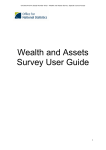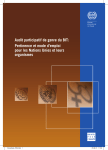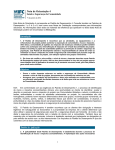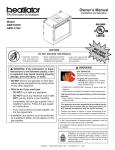Download THE BENCH MARKS: A USER'S GUIDE
Transcript
THE BENCH MARKS: A USER’S GUIDE ECCR The Ecumenical Council for Corporate Responsibility September 2006 CONTENTS 1. Introduction 3 2. What are the Bench Marks? The Bench Marks approach 4 4 3. Bench Marks themes and stakeholder groups The wider community The corporate business community 5 5 7 4. Using the Bench Marks Stakeholder groups Making links Developing a framework for research, measurement and action Measuring company performance Measuring: an example Engaging with companies and effecting change Developing an ethical investment policy Conclusion 12 12 13 13 14 14 16 17 18 Appendix: Sources of further information Bench Marks partners (Global Principles Steering Group) Other faith-based organisations and networks working on corporate issues Corporate responsibility codes, guidelines and resources Ethical and socially responsible investment NGOs working on corporate responsibility Trade unions 19 19 19 19 20 20 20 Acknowledgements This Guide was written by Suzanne Ismail. Comments were provided by Tony Addy, John Capel, Barbara Hayes, Stephen Hine, Miles Litvinoff, Roy Moore, David Schilling, Jiří Silný, Bridget Walker and Crispin White. ECCR is grateful to the European Commission (Employment, Social Affairs and Equal Opportunities DG) for funding the production of this Guide. Your comments ECCR would welcome readers’ and users’ comments on this Guide. Please contact us via [email protected]. The Bench Marks: A User’s Guide 2 1. INTRODUCTION Companies are one of the major driving forces in today’s globalised economy. Transnational corporations (TNCs) have a wide reaching impact, and there is increasing debate about the costs and benefits of their activities and their responsibilities towards all those affected. These include not only shareholders, but also workers, the communities where the TNC carries out its operations, and the environment. One comprehensive tool for anyone working on corporate responsibility issues is the document Principles for Global Corporate Responsibility: Bench Marks for Measuring Business Performance – also known as the Bench Marks (available at www.bench-marks.org). The Bench Marks have been developed by an international group of faith-based organisations concerned about some of the effects that companies might have and seeking to promote responsible corporate behaviour. This Guide is designed to make the Bench Marks a more accessible resource and to help people and organisations use the document to work on corporate responsibility issues more effectively. The Guide will be of particular interest to communities, groups and individuals based in ‘host’ countries (countries where companies operate) who have been affected by company activities, to corporate responsibility advocates based in companies’ ‘home’ countries (countries where companies are registered or have their head offices) and to faith-based and ethical investors. For communities and corporate responsibility advocates, we hope that this Guide, together with the Bench Marks themselves, will provide a framework for assessing the extent to which companies are operating responsibly, as well as for identifying areas of corporate behaviour where there may be potential concerns. The Guide should also help users identify opportunities and develop strategies for engaging with companies about these issues. Investors and shareholders will also have an interest in analysing corporate performance and in engaging with companies. We also hope that the Bench Marks will enable users to define and implement ethical investment policies, helping ensure that investments do not support activities that are harmful or against investor beliefs. The Bench Marks: A User’s Guide 3 2. WHAT ARE THE BENCH MARKS? The Bench Marks are designed to measure the extent to which a company is operating in a way that can be considered, from a faith perspective, to be responsible. The document is the result of over 12 years of collaboration between ECCR and an international group of faith-based organisations1 and of consultation with business and non-governmental organisations (NGOs). Faith communities measure the global economy not only by what it produces, but also by its impact on the environment, how it touches human life and whether it protects the dignity of the human person.2 The Bench Marks are not a code of conduct but a tool for measuring. In some instances the Bench Marks draw on existing codes such as those produced by the International Labour Organisation and the United Nations; in others they define new measures. The Bench Marks approach Each section of the Bench Marks identifies different stakeholders (people or groups) or issues that might be affected by corporate activity and then considers the various ways in which a company has responsibilities concerning these. The approach used is to start with general principles that faith communities believe are fundamental if a business is to act in a responsible way. More detailed policies and indicators are then developed which enable the user to identify the extent to which those principles are being upheld. Three different levels of analysis are used to do this: Principles, Criteria and Bench Marks. Principles: These are statements of business philosophy fundamental to a responsible company’s actions. Criteria: These are particular company policies and/or practices that can be compared for consistency with the Principles. Bench Marks: These are specific reference points of measurement to be used in assessing the company’s performance in relation to the Criteria. 1 The most recent version of the Bench Marks text (www.bench-marks.org), revised and published in 2003, was agreed by the Global Principles Steering Group, composed of six organisations based in Australia, China (Hong Kong), the USA, South Africa, Colombia and the UK. The steering group was commissioned at a conference in 1999 by representatives from 21 countries, mostly in the developing world. Members of the steering group and their web addresses are listed in the Appendix . 2 The theological basis of the Bench Marks is set out on page 1 of the document. The Bench Marks: A User’s Guide 4 3. BENCH MARKS THEMES AND STAKEHOLDER GROUPS3 A number of common themes and principles underlie the Bench Marks document and are relevant to many of the stakeholders and issues considered in the text. These include the following: • Corporations have a responsibility to ensure that all aspects of their production cycle cause minimum harm to people and the environment. • Responsible corporations properly consult stakeholders before making final decisions about activities that affect them. • Responsible companies employ comparable standards across all of their operations. They do not use lower legal requirements in host countries to avoid applying those that would be required at home. • Effective corporate codes of conduct are drafted with input from those who will be affected by them and have to implement them. • Clear lines of responsibility and accountability are necessary for companies to properly implement corporate responsibility policies and practices. • Responsible companies have clear systems for monitoring their environmental and social impacts and enable communities and civil society to contribute to this. • Responsible companies provide publicly available and externally verified reports, giving comparable information about the social and environmental impacts of each of their operations. The specific themes and stakeholders considered by the Bench Marks are divided into two categories, each of which forms one part of the Bench Marks document. Part 1 deals with the Wider Community. This includes stakeholders and issues external to the company including neighbouring communities, the environment and the wider society in which the company operates. Part 2 deals with the Corporate Business Community, which refers to stakeholders and issues connected to the company's internal structures. This part of the Bench Marks considers employees, suppliers, the company's customers and its business partners. It also considers how a company arranges its financial affairs and develops an ethical internal culture. A brief synopsis of each of the stakeholders and issues considered by the Bench Marks and how a responsible company would act in relation to these is given below. Part 1. The Wider Community Ecosystems (section 1.1) All forms of corporate activity have some impact on the environment, both directly as a result of production and indirectly through the use or disposal products. Responsible companies are able to show how they are working to minimise their overall environmental impact. The ‘precautionary principle’ (i.e. proving that a process or action is safe before implementing it) underpins decision-making. Indicators in the Ecosystems section may be particularly relevant to the following industrial sectors: 3 Some of the text in this section has been based on the content of KAIROS; Canadian Ecumenical Justice Initiatives, Corporate Responsibility: A Field Action Guide (2002), which can be ordered at: www.kairoscanada.org/e/corporate/links.asp. The Bench Marks: A User’s Guide 5 • • • • • • Extraction (mining, oil, gas, forestry) Manufacturing - particularly of hazardous or difficult to dispose of items Transportation Large scale food production and agriculture Chemicals Companies producing or using genetically modified ingredients. National Communities (section 1.2) This section addresses the impact a company has on economic, political and social life in each of the countries in which it operates. A responsible company will take steps to ensure that its actions do not violate human rights and that it is not complicit in human rights abuses committed by others. Business will be done in a way that does not cause or enflame political tensions or contribute to civil strife. National legislation will be upheld, including laws governing the payment of taxation. Indicators in the National Communities section are likely to apply to all multinational companies, particularly those with a key role in the national economy. They may be of particular relevance to: • Companies operating in countries associated with human rights problems • Companies operating in countries where there is civil or political unrest • Companies producing armaments or other equipment for military use. Local Communities (section 1.3) A company’s primary impact is likely to be on the communities immediately neighbouring its operations. Local communities are part of National Communities, but their interests are not necessarily fully aligned. For example, a major opencast mine might result in a large amount of taxation being paid to the national government. This should benefit all citizens, but the communities living nearest to the mine might feel that this benefit is outweighed by the costs of increased noise and pollution that they experience or the risks that they bear - for example, if there was a major fire or safety failure at the site. Responsible companies will seek to involve local communities in all aspects of their operations and will enable communities to influence their business plans. Corporate policies and practices will pay attention to the basic principle of social justice rather than be based on traditional 'philanthropic' approaches. Indicators in the Local Communities section are likely to apply to all companies. They may be particularly relevant to: • Companies whose activities have a major social, environmental or economic impact on the area surrounding their operations. This could include mining, oil and gas, forestry, major manufacturing and chemicals plants. Indigenous Communities (section 1.4) Indigenous peoples can be particularly vulnerable when a company operates on or near their traditional lands. An influx of workers, the expansion or development of towns and the introduction of money can have serious implications for indigenous societies. However, The Bench Marks: A User’s Guide 6 corporate activity could also help indigenous communities develop new skills and gain employment. The principle of prior rights requires companies to pursue economic development only if land claims have been resolved between indigenous peoples and governments. A responsible company will seek and receive approval from indigenous leadership before beginning business activities and will work in partnership with indigenous communities to ensure that its activities provide benefit and do not cause harm. Indicators in the Indigenous Communities section are likely to be of particular relevance to: • Companies using large amounts of land or natural resources, such as mining, oil and gas, and forestry companies • Pharmaceutical or ‘bio-prospecting’ companies developing products based on natural resources which may be closely linked to traditional knowledge systems • Companies operating in countries with indigenous and tribal populations as defined by the International Labour Organisation in Convention 169 concerning Indigenous and Tribal Peoples in Independent Countries.4 Resource Extraction (section 1.5) Extractive industries have had an unhappy reputation for being associated with human rights abuses, environmental destruction, social upheaval and negative effects on indigenous people. Effective consultation and environmental management systems, respect for human rights and financial transparency are essential if resource extraction is to contribute to long-lasting community benefits which outlive the life of a resource extraction project. Indicators in the Resource Extraction section are likely to be of specific relevance to: • Oil and gas companies • Mining companies • Forestry companies. Part 2. The Corporate Business Community The Employed - Conditions (section 2.1) The employer–employee relationship is one of the most fundamental to any company. A responsible company's starting point for the way it conducts this relationship is the inherent dignity of humanity. Employment policies will be guided by International Labour Organisation standards and will safeguard the rights of employees to join trade unions, to bargain collectively and to work without fear of discrimination. Responsible companies ensure that all of their employees are treated respectfully and remunerated in a way that enables them to provide for themselves and their dependants. Work schedules will not prevent employees carrying out their family responsibilities. Indicators in the Employed – Conditions section will apply to all companies. They may be of particular relevance to: • Companies with large workforces in developing or rapidly industrialising countries 4 Information on ILO Convention 169 concerning Indigenous and Tribal People can be found at www.ilo.org/public/english/indigenous/standard/index.htm. The Bench Marks: A User’s Guide 7 • Companies operating in traditionally male-dominated industries • Companies operating in Export Processing Zones or other areas or countries where trade union activity is discouraged or prevented.5 The Employed - Health & Safety (section 2.2) A key aspect of an employer’s relationship with its workers is its duty of care to ensure a safe, healthy working environment. A responsible company will ensure that workers are fully involved in developing health and safety policies and in the monitoring of health and safety performance. Where accidents occur, affected workers receive treatment and will be found suitable jobs if they cannot return to their original position. Companies also have a responsibility towards employees affected by HIV/AIDS, particularly where government initiatives on HIV/AIDS are lacking. Indicators in the Employed – Health and Safety section may be of particular relevance to: • Heavy industry and manufacturing companies • Transportation companies • Companies with operations in countries with a high HIV/AIDS infection rate • Chemical industries • Construction companies • Companies operating in countries where health and safety awareness and implementation are lacking. The Employed – Persons (section 2.3) Certain sectors of the workforce may encounter particular problems or have particular vulnerabilities. These may include women, minority groups, persons with disabilities, children and those working under forced or bonded conditions. Women, Minority Groups and Persons with Disabilities (subsections 2.3a-c) Even in countries with strict anti-discrimination laws, there are often challenges at work for women, members of minority groups, and persons with disabilities. Responsible companies will have clear non-discrimination policies as well as mechanisms to enforce and monitor these. Physical adaptations will be made to the workplace to enable people with disabilities to function. Training will be given to enable all employees, but especially those who may be disadvantaged, to advance within the workplace. Indicators in these subsections will be relevant to all companies. Child Labour (subsection 2.3d) In many countries children have to work in order to live. These children's education and personal development can be severely hampered. Child workers are also particularly susceptible to accidents and industrial disease. A responsible company has systems to ensure that child workers are not exploited and does not 5 Information on trade union rights and how trade unionists perceive the observance of those rights in over 130 countries can be found in the International Confederation of Free Trade Unions’ Annual Survey of Violations of Trade Union Rights. The 2006 survey is available at: www.icftu.org/survey2006.asp?language=EN. The Bench Marks: A User’s Guide 8 offer full time work to children below the age of completion of compulsory schooling. Young workers are monitored, and if exploitation is discovered, steps are taken to remedy this. The simple dismissal of children is not the solution, and responsible companies will look for alternative solutions that ultimately re-integrate children into schools and the community. Indicators in the Child Labour subsection will be applicable to all companies sourcing goods from countries with acknowledged child labour problems and in sectors known to be associated with child labour.6 These sectors include: • Garment and footwear manufacture • Textile manufacture • Toy manufacture • Carpet and rug industries • Agriculture. Forced Labour (subsection 2.3e) Working from the principle of treating people with dignity and respect, responsible companies will only employ workers who choose to work for them. The recruitment of workers under the threat of violence or other penalties, bonded labour, slave labour and prison labour are forms of forced labour. Responsible companies adhere to International Labour Organisation conventions dealing with forced labour and employ effective monitoring systems to detect if people are working under duress. Indicators in the Forced Labour subsection are likely to be particularly relevant to: • Companies sourcing goods produced in countries ruled by oppressive regimes • Companies sourcing goods produced in countries acknowledged as having problems with forced labour.7 Suppliers (section 2.4) Many companies do not directly produce all of the goods they sell, but are dependent on a complex network of suppliers to provide them. Those suppliers are often under considerable pressure to reduce their own costs, so there is a risk that goods may be produced in unsafe environments or that workers are paid low wages. Responsible companies recognise that they have a responsibility towards people they employ indirectly through supplier companies. They will work with suppliers to develop codes of conduct, monitoring systems and a plan of action to ensure that employees work in safe and healthy conditions. 6 According to the ILO report The End of Child Labour: Within Reach (2006), the regions with the highest incidence of child labour are Sub-Saharan Africa and Asia and the Pacific where 26.4% and 18.8% of 5-14–year-olds respectively are economically active. See: www.ilo.org/iloroot/docstore/ipec/prod/eng/2006_cl_globalreport_en.pdf. Detailed country-level statistics on child labour are available from the ILO’s Statistical Information and Monitoring Programme on child labour: www.ilo.org/public/english/standards/ipec/simpoc/index.htm. 7 According to the ILO report Minimum Estimate of Forced Labour in the World (2005), three-quarters of the total number of the world’s people subject to forced labour are in the Asia and Pacific region, 11% of the total in Latin America and 5% in Sub-Saharan Africa. See: www.ilo.org/dyn/declaris/DECLARATIONWEB.DOWNLOAD_BLOB?Var_DocumentID=5073. The Bench Marks: A User’s Guide 9 Indicators in the Suppliers section may be particularly relevant to: • Retail companies • Clothes and textile manufacturers • Footwear manufacturers. Financial Integrity (section 2.5) Corporate financial practices have come under scrutiny in the light of several high profile corporate collapses in 2001-2. In addition, it is now acknowledged that payments made by transnational corporations may be a source of bribery and corruption in some countries. Responsible companies have clear mechanisms and monitoring systems to ensure that conflicts of interest are avoided and that all financial transactions are properly accounted for and made for legitimate purposes. They will also ensure that their investments respect the environment and support human and community needs. Indicators in the Financial Integrity section are applicable to all companies. They may be particularly relevant to: • Financial service providers • Companies operating in countries with high levels of corruption.8 Ethical Integrity (section 2.6) If companies are to uphold high ethical standards, commitment is required at the highest level. On their own, codes of conduct are not sufficient. Training, awareness raising and mechanisms by which employees can report concerns without fear are some of the elements required for a company to develop a corporate culture that emphasises corporate responsibility. Corporate lobbying has the potential to undermine positions set out in companies' ethical policy statements. Responsible companies will guard against this and report publicly on their lobbying activities. Indicators in the Ethical Integrity section are applicable to all companies. They may be of particular relevance to: • Companies that are members of industry associations associated with lobbying • Companies operating in countries and contexts where political lobbying is common. Corporate Governance (section 2.7) A responsible company structures itself in a way which reduces the risk of managers acting against the long term interests of shareholders, employees and other stakeholders. Good corporate governance will ensure that a company is transparent about all major activities and its future prospects. Indicators in the Corporate Governance section will be applicable to all companies, but particularly to large, transnational companies with complicated financial systems or management structures. 8 One measure of corruption levels within countries is Transparency International’s Corruptions Perceptions Index, published annually. The most recent version can be found at www.transparency.org/policy_research/surveys_indices/cpi/2005. The Bench Marks: A User’s Guide 10 Shareholders (section 2.8) Publicly listed companies have a number of legal obligations to their shareholders. Shareholder rights include access to certain information, attendance at Annual General Meetings (AGMs) and having the opportunity vote to approve (or disapprove) of the way the company is being run. In many cases shareholders also have the right to submit shareholder resolutions whereby proposals are voted on by other shareholders.9 A responsible company will uphold the letter and the spirit of regulations regarding shareholder responsibility. It will be committed to meeting shareholders and will respect their right to ask questions and submit proposals. Indicators in the Shareholders section are relevant to all companies whose shares can be publicly traded. Joint Ventures / Partnerships / Subsidiaries (section 2.9) The Bench Marks recognise that companies have a responsibility for the actions of joint venture partners, subsidiaries and other close business partners. Responsible companies will promote the uptake of high ethical, social and environmental standards by partner organisations. They have mechanisms in place to monitor partners’ activities and to take action when problems are identified. Indicators in this section are applicable to all companies that enter into joint venture or partnership agreements or that have subsidiaries. Customers and Consumers (section 2.10) Companies have a responsibility to deal honestly and fairly with their customers. Responsible companies will be able to demonstrate compliance with advertising standards legislation, will not be involved in price fixing and will not produce or market goods that they know or believe to be harmful to health or the environment. Their products are likely to have received positive evaluations from independent consumer organisations. Indicators in the Customers and Consumers section are applicable to all companies. 9 Law governing shareholder resolutions varies from country to country. Generally, ordinary shareholders have the right to file or co-file a shareholder resolution, although in some countries they must have held shares for a number of months before they can do so. The Bench Marks: A User’s Guide 11 4. USING THE BENCH MARKS The Bench Marks can be used in a number of different ways. As well as being used to measure corporate responsibility, the document can help to inform engagement (dialogue) with companies and in the development of ethical investment policies. Stakeholder groups In this section we concentrate on how three different groups of stakeholders might use the Bench Marks. Host country communities Communities living or working near to company operations are often the stakeholders most obviously affected by corporate activities. The Bench Marks aim to support communities by enabling them to compare their experience of corporate activity with an internationally agreed framework of what communities should be able to expect from a responsible company. Where community experience does not measure up to these expectations, communities may wish to engage in dialogue with the company to inform it about the impact of its operations or to propose solutions to particular problems. The indicators listed in the Bench Marks should help provide questions and arguments to encourage companies to take the views and needs of communities into account. Home country NGOs and faith communities Faith communities, NGOs and individuals based in the company’s home country may be interested in corporate behaviour for a number of reasons. They may have a general concern about the activities of companies and be carrying out research to determine the extent to which corporate behaviour can be deemed responsible. Or they may have been contacted by a host community about a particular problem. The indicators listed in the Bench Marks should help these groups plan their research, analyse corporate behaviour and if necessary raise their concerns with the company involved. Shareholders Company shareholders can vary from large institutions, which professionally invest huge sums of money in the stock market, to individuals who have bought a small number of shares in companies they have selected themselves. Some shareholders may want to invest only in companies or economic sectors which they consider to be ethical. These investors may find the Bench Marks useful in defining an ethical investment policy and then developing a research framework to help measure the extent to which companies they are considering investing in can be seen as responsible. Others, whether or not they exclude certain companies from their investment portfolios, may choose to monitor the ethical performance of companies that they invest in and engage with those companies to discuss issues of potential concern. These investors may also find the Bench Marks useful in defining a framework for researching company performance and measuring the extent to which corporate behaviour is acceptable. As above, if potential problems are discovered, the Bench Marks can help prepare for engagement. The Bench Marks: A User’s Guide 12 Making links Although three separate categories of Bench Marks user are listed above, experience shows that the most effective work advocating corporate responsibility often happens when links are made between these groups. For example, whilst host communities often have detailed, powerful information at first hand about what a company is doing, when they try to raise concerns with foreign companies their voices might be sidelined or ignored. If host communities are able to convince home faith communities, NGOs or shareholders to work with them, they may find that company managers are more likely to listen and respond to their concerns. Equally, whilst shareholders and NGOs may be in a better position to raise those concerns, without detailed evidence of ‘on the ground’ impacts, they may not have enough information to inform those discussions. Information flows work both ways. Whilst communities may have detailed information about the local impacts of a company, they might be less knowledgeable about its structure or ownership, or about international agreements that could have a bearing on a particular problem. ECCR has in the past provided overseas partners with information on company structures and policies that have been relatively easy to obtain from a home country but less easy to obtain from abroad. Partners have been able to compare that information with the experiences of impacted communities. Where there have been discrepancies between the two, ECCR has been able to raise this in meetings with company executives and to communicate their responses back to community groups. Developing a framework for research, measurement and action When using the Bench Marks to research and measure company performance or as a basis for engaging with a company, it will rarely be necessary to use the entire document. Some Bench Marks sections may not be relevant to the company in question. For example, section 1.5 on Resource Extraction will have little relevance when looking at a retail company. Other sections may be relevant on the whole but contain some irrelevant indicators. For example, section 1.2 on National Communities will generally be applicable to many companies; however, Criteria 1.2.C.8 and 1.2.C.9 contained within it are only applicable to companies producing drugs or tobacco. At the same time there will probably be a number of sections within the Bench Marks that could technically apply to a company but will be of less concern compared to other potential corporate impacts. For example, when looking at an oil and gas company with a largely skilled workforce, the likelihood of children being employed is relatively low. Whilst it would be possible to assess the company against subsection 2.3d on Child Labour, the resources needed to do this would probably be better employed by assessing it against sections 1.1-1.5 on Ecosystems, National, Local and Indigenous Communities and Resource Extraction. Because of this, at the start of any project, users may find it helpful to draw up a list of the most relevant section(s) of the Bench Marks and the specific indicators within each section that they wish to measure against. Such a list will essentially give a framework for research that will help the user look for sources of information which could provide the evidence needed to effectively measure corporate performance in those areas. Some Bench Marks users may want to compare two or more companies in the same sector, or how different types of companies respond to the same issue. When doing this it is important to ensure that the same sections and indicators are The Bench Marks: A User’s Guide 13 considered in each case to allow easy and meaningful comparison. The sections of the Bench Marks that should be considered for each type of company or economic sector will depend both on the particular concerns of the user and on the specific activities and geography of the companies concerned. Some suggestions about the sectors and type of company to which each Bench Marks section may be relevant are given above in section 3 of this Guide. However, in each case it will also be helpful to undertake some basic research on what the company does and where and how it operates in order to define the most relevant sections of the Bench Marks document to use. Measuring company performance Having a measure of the extent to which a company is acting responsibly allows stakeholders to make informed decisions about the company and their relationship with it. Using the Bench Marks helps to make measuring corporate performance a relatively straightforward, although sometimes time-consuming, process. It can be done by any stakeholder with access to information and able to research how the company operates. The first step is, as above, to draw up a framework of relevant Bench Marks indicators. When doing this ECCR tends to focus on Criteria and Bench Marks rather than the Principles level of analysis. This is because whereas Principles remain relatively general and aspirational, Criteria and Bench Marks give specific references to policies and outcomes that can be more easily measured. The next stage is to compare each of the indicators within the framework with whatever information is available about how the company operates. For host communities and groups with links to them, such information may be based on personal experiences or testimonies. Other stakeholders will probably need to rely on sources including company reports and websites, NGOs working in areas where the company operates, the media and some regulatory bodies. From these it should be possible to make a judgement about whether or not the company has fulfilled the requirements of each indicator. Users may find that they do not have enough information to judge how the company performs in relation to some indicators. This partly reflects the fact that the Bench Marks are an extremely comprehensive document; however, it can also reflect a lack of transparency on the part of the company concerned. Measuring: an example A group concerned about indigenous peoples’ rights wishes to measure the extent to which companies enable indigenous people to gain employment. In order to do this, the group would need to use Bench Marks section 1.4, which deals with companies’ responsibilities towards indigenous peoples. Because employment is the only issue the group is interested in, it makes sense that it only looks at Bench Marks and Criteria connected with employment. These are 1.4.C.6, 1.4.C.8 and 1.4.B.5, which state: ‘The company’s employment policies and practices fully accommodate the cultural, spiritual and social needs of employees who are members of indigenous communities.’ (1.4.C.6) ‘The company provides employment and training opportunities for, and actively recruits from, indigenous communities for all levels of employment.’ (1.4.C.8) And The Bench Marks: A User’s Guide 14 ‘The company’s business plans, and its employment policies and practices are communicated clearly and are available in indigenous languages in both written and oral form.’ (1.4.B.5) The group would then need to compare these indicators with relevant companies’ employment policies, together with any experiences of indigenous communities with which the group has links. The group might find that one company’s website states that it wants to increase the proportion of indigenous people within its workforce and that vacancies are advertised on radio stations serving areas where indigenous communities live. Information about those vacancies is available in indigenous languages; and instead of filling out an application form, potential employees are able to show their suitability for the roles in question through demonstrating some of the tasks needed as part of the job. Assuming there were no reason to doubt these statements, this would demonstrate some kind of corporate commitment to the inclusion of indigenous people within the workforce. The fact that the company appears to be actively recruiting indigenous workers fulfils part of indicator 1.4.C.8; however, it does not fulfil the indicator completely because there is no information about whether training is given to indigenous people. Because information on jobs is available in indigenous languages and communicated over the radio, and the application process is not a written one, the group might consider that the company has fulfilled the points set out in 1.4.B.5 with regard to employment policies and practices. However, from this information alone, it would not be possible to determine whether or how the company sought to accommodate the social, cultural and spiritual needs of employees from indigenous communities as stated in Criterion 1.4.C.6. To do this the group may need to ask the company directly. It may also wish to consult indigenous employees to determine whether, in their view, the company’s approach was adequate. Having completed an exercise like this, some Bench Marks users like to quantify the way they measure company performance, for example by awarding a company one point for each of the indicators fulfilled, then working out the proportion of fulfilled indicators in relation to all of those considered. ECCR’s Canadian partner organisation KAIROS (formerly the Taskforce on Churches and Corporate Responsibility) has devised a system to assess corporate responsibility and transparency at the same time.10 This approach awards one point for showing commitment or implementation of each indicator (part-points being given if the indicator was only partially implemented), zero points if the company literature made clear that it did not fulfil an indicator, and minus one point if the company did not provide enough information to enable stakeholders to determine whether or not a particular indicator had been fulfilled. (A negative score is given for the latter on the basis that being transparent about not having a particular policy or practice is better than non-transparency.) 10 Taskforce on Churches and Corporate Responsibility, Corporate Social & Environmental Responsibility: Commitment, Conduct & Transparency (2000); see: www.iccr.org/news/press_releases/GP_pressconf/pr_kairos.htm. The Bench Marks: A User’s Guide 15 This type of quantitative approach will allow the ranking of companies according to their level of corporate responsibility. This may be of particular use for ethical investors who wish to invest in companies considered to be the most responsible in their sector (`best in class’). Other users prefer simply to list the indicators that they have measured against, stating whether or not there is evidence that the company fulfils them. This list can then be used to help plan and prioritise further action such as research, engagement or investment decisions about the company. A table based on the example above might look something like this: Indicator Evidence 1.4.C.6 The company’s employment policies and practices fully accommodate the cultural, spiritual and social needs of employees who are members of indigenous communities. 1.4.C.8 The company provides employment and training opportunities for, and actively recruits from, indigenous communities for all levels of employment 1.4.B.5 The company’s business plans, and its employment policies and practices are communicated clearly and are available in indigenous languages in both written and oral form. No Priority for engagement? Yes Yes on recruitment. Unclear on training. Yes Yes No Notes Request more information. If necessary promote uptake of policies. Request information on training. Engaging with companies and effecting change Engaging with companies can happen in a number of ways. Methods can include relatively lowkey activities such as writing a letter or having a private meeting with company executives to raise issues of concern and to see what the company has to say about them. Other, more public options include asking a question at a company AGM, inviting a company representative to discuss the issue at a public meeting or working with other shareholders to submit a shareholder resolution. Not all of these options are open to all stakeholders and some require far more resources than others. For example, it is necessary to hold shares in a company to ask a question at an AGM, whereas any stakeholder can write a letter. When deciding which method to adopt, stakeholders will need to be clear about their ultimate aim and how the company is likely to respond to them. Most stakeholders engage with companies either to find out more information about a particular situation or to encourage the company to adopt certain policies or practices or to take the views of other stakeholders into account. Measuring company performance according to the Bench Marks framework and drawing up a table of where the company does and does not measure up to Bench Marks indicators can help in both these cases. The Bench Marks: A User’s Guide 16 For those seeking extra information, a list of Bench Marks indicators where it has been determined that there is insufficient evidence to measure corporate conduct will essentially provide a list of questions that could be posed to the company in a meeting or a letter. For those who wish to influence a company, a list of indicators to which the company clearly does not ‘measure up’ can help determine key issues for discussion. In addition, the Principles behind those indicators can help to provide arguments that could be used to promote change. The fact that the Bench Marks are an internationally agreed framework, used by faith-based investors and others to assess the extent to which a company can be considered to be responsible, can provide a reason for asking for information and for promoting change. A good first step for the group in the example above would be to write to the company to ask what practices exist to accommodate indigenous employees’ cultural, social and spiritual needs, and whether any special training is given to indigenous communities or employees, as per indicators 1.4.C.6 and 1.4.C.8 respectively. One approach might be to start by commending the company for recognising that it needs to include indigenous peoples within its workforce. The group could then go on to state that more information is needed to enable stakeholders to measure the extent to which the company is acting responsibly towards its indigenous employees according to the Bench Marks framework. The group could emphasise that without such information, stakeholders are likely to make a less favourable assessment of the company than may be warranted in reality. Upon such questioning, it may become apparent that the company has no substantive policies to accommodate the needs and practices of indigenous employees. In this situation the next step might be to find out why and, if necessary, to try to persuade the company to develop them. This could be done through further correspondence or by requesting a meeting with company executives. The group could point out that policies to increase indigenous recruitment are not ultimately likely to succeed if that employment comes at the cost of not observing indigenous culture and traditions. If the company can show that it actively works to preserve those values, communities, employees, shareholders and other stakeholders would see it as being far more responsible towards indigenous people. Developing an ethical investment policy Although the Bench Marks do not aim to tell users how to invest, a number of ECCR members have reported that they have found the document a useful tool when developing their ethical investment policies. An ethical investment policy sets out the principles that underpin an individual’s or organisation’s approach to investment. Usually it will give details of any activities or industries considered unsuitable for investment on ethical grounds. Many policies also set out key issues, such as commitment to human rights or environmental protection, that should be taken into account when deciding whether or not companies are ethically suitable to invest in. A policy may also state whether the investor engages with companies about issues of potential ethical concern. Policies usually reflect the particular values, concerns and resources of the individuals or organisations that have made them and as such are likely to vary considerably from organisation to organisation. The Bench Marks: A User’s Guide 17 The Bench Marks can be used to help organisations think about how they want to invest. By considering each of the Bench Marks stakeholder and issue groups, organisations and individuals may find it easier to decide for themselves what sort of issues should be covered by an ethical investment policy. The Bench Marks do not however state what sort of approach should be used towards investments, nor whether particular types of companies should be excluded from investment portfolios on ethical grounds Potentially all of the stakeholders and issues considered by the Bench Marks could be included within an ethical investment policy. However, few investors will have the resources required to research, analyse and measure the performance of every company that they are considering investing in against the whole Bench Marks document. Most investors will therefore need to pick out the issues they are most concerned about for inclusion within their own policy. Similarly, so that they can be relatively easily applied to a range of different companies, ethical investment policies tend not to contain many detailed indicators; instead they focus on general principles. An ethical investment policy is more likely to state, ‘We seek to invest in companies which work to protect human rights’ than ‘We seek to invest in companies which have a verifiable human rights policy, have a senior executive responsible for upholding human rights, consider the human rights implications of entering into business relationships, etc.’ When developing the text of an ethical investment policy, therefore, users will probably find it most helpful to focus on the more general Principles level of analysis within the Bench Marks. Some investors may choose to supplement these general ethical investment policy statements with more detailed frameworks for analysing corporate behaviour. Such frameworks could be used to determine whether or not companies’ specific policies and practices uphold the principles set out in an ethical investment policy and could be based on the Bench Marks in a similar way to those developed on pages 14-16 above. Conclusion The debate about the costs and benefits of corporate activity is becoming more and more visible and now encompasses governments, consumers, companies, unions, faith communities, charities, NGOs, investors, the media and many others. There are many different approaches to these issues but few universally accepted solutions to the challenge. It is hoped that by offering an internationally accepted basis for measuring levels of corporate responsibility, the Bench Marks will both help to inform the wider debate and provide a practical tool to help corporate responsibility advocates and others ensure that corporate activities are beneficial to people, the wider community and the environment as well as providing financial returns. The Bench Marks: A User’s Guide 18 APPENDIX: SOURCES OF FURTHER INFORMATION Bench Marks partners (Global Principles Steering Group) Bench Marks Foundation of Southern Africa: www.bench-marks.org/befsa CENSAT Agua Viva / Friends of the Earth Colombia: www.censat.org Christian Centre for Socially Responsible Investment (Australia): www.ccsri.org Ecumenical Council for Corporate Responsibility (UK): www.eccr.org.uk Hong Kong Christian Industrial Committee: www.cic.org.hk Interfaith Center on Corporate Responsibility (USA): www.iccr.org KAIROS: Canadian Ecumenical Justice Initiatives: www.kairoscanada.org Other faith-based organisations and networks working on corporate issues Conference of European Churches: www.cec-kek.org Ecumenical Advocacy Alliance: www.e-alliance.ch Industrial Mission Movement: www.industrialmission.org/pages/links.html www.imaonline.org.uk (under construction) World Council of Churches, Commission on Justice, Peace and Creation: http://wcccoe.org/wcc/what/jpc/index-e.html Corporate responsibility codes, guidelines and resources European Commission, ABC of the Main Instruments of Corporate Social Responsibility, 2004 a useful overview of different corporate responsibility instruments and what is happening at the EU level: http://ec.europa.eu/employment_social/publications/2005/ke1103004_en.html Extractive Industries Transparency Initiative: www.eitransparency.org Global Reporting Initiative: www.globalreporting.org International Labour Organisation conventions: www.ilo.org/ilolex/english/convdisp2.htm Organisation for Economic Co-operation and Development (OECD), Convention on Combating Bribery of Foreign Public Officials: www.oecd.org/document/20/0,2340,en_2649_34859_2017813_1_1_1_1,00.html OECD, Guidelines for Multinational Enterprises: www.oecd.org/document/28/0,2340,en_2649_34889_2397532_1_1_1_1,00.html United Nations (UN) Global Compact: www.unglobalcompact.org UN Norms on the Responsibilities of Transnational Corporations and Other Business Enterprises with Regard to Human Rights: www1.umn.edu/humanrts/links/norms-Aug2003.html UN Principles for Responsible Investment: www.unpri.org Voluntary Principles on Security and Human Rights: www.voluntaryprinciples.org The Bench Marks: A User’s Guide 19 Resources Business and Human Rights Resource Centre - a comprehensive internet resource with links to information about corporate responsibility from governments, companies, intergovernmental organisations and NGOs: www.business-humanrights.org Christian Aid, Behind the Mask: The Real Face of Corporate Social Responsibility, 2004 - offers a critique of current voluntary approaches to corporate responsibility and argues that binding corporate regulation is needed: www.christian-aid.org.uk/indepth/0401csr/index.htm UK Government website on corporate social responsibility: www.csr.gov.uk Ethical and socially responsible investment See also Bench Marks partners above Ethical Investment Research Services (EIRIS): www.eiris.org European Ethical Shareholders Network: www.ethicalshareholders.net European Social Investment Forum: www.eurosif.org International Interfaith Investment Group (3iG): www.3ignet.org National Council for Voluntary Organisations, guide to developing an ethical investment policy: www.ncvo-vol.org.uk/askncvo/funding/index.asp?id=117 Pensions Investment Research Consultants: www.pirc.co.uk UK Social Investment Forum: www.uksif.org Selected NGOs working on corporate responsibility CAFOD: www.cafod.org.uk Christian Aid: www.christianaid.org.uk Corporate Europe Observatory: www.corporateeurope.org Corporate Responsibility (CORE) Coalition: www.corporate-responsibility.org Corporate Watch: www.corporatewatch.org Corpwatch: www.corpwatch.org European Coalition for Corporate Justice: www.corporatejustice.org Trade unions European Trade Union Confederation: www.etuc.org International Confederation of Free Trade Unions (ICFTU): www.icftu.org - website containing information on and links to independent trade union movements around the world Trade Union Advisory Committee (TUAC) to the OECD: www.tuac.org The Bench Marks: A User’s Guide 20































